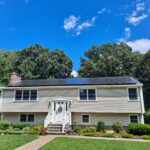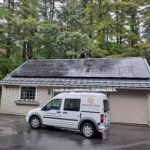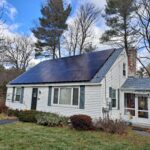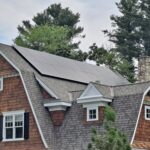What better example can a President set to guide the country to a more sustainable path than to put solar panels on his own home? Many environmental organizations and companies have banded together to encourage President Obama to install a new set of solar panels on the White House.
In 1979, Jimmy Carter became the first President to put 32 solar panels on the White House in the midst of the second oil crisis. The first group of panels installed just above the Oval Office was solar thermal and exclusively used to heat water in the White House staff kitchen. His forward-looking perspective on renewables created the first wave of innovation and research on solar technology in the United States. The day the system was unveiled, Carter delivered a speech full of optimism for the potential of renewable energy:
This dependence on foreign sources of oil is of great concern to all of us. In the year 2000, the solar water heater behind me which is being dedicated today will still be here supplying cheap efficient energy. A generation from now this solar heater can either be a curiosity, a museum piece, an example of a road not taken, or it can be just a small part of the greatest and most exciting adventures ever undertaken by the American people.
I guess you can say the solar panels were an example of a road not taken. In 1986, the White House roof required repairs and Ronald Reagan had the panels removed. He never ordered that they be reinstalled and squelched many of the solar programs that Carter put in place. Some people believe that Reagan had purposefully not re-installed the solar panels to advance his own political agenda. Others say that the President did not put the panels back on the White House because it wasn’t cost efficient. I think the former seems more believable.
The White House panels were later found in government storage in Franconia, Virginia, just outside of Washington, DC. With the help of actress Glenn Close, they were acquired in 1991 by Unity College, a liberal arts college that emphasizes the environment and natural resources in their curriculum. The college refurbished 16 of the solar thermal panels to heat water for their cafeteria. The system continued to be in operation until 2005. Although the system is no longer in use, the solar panels are still atop the school’s cafeteria as a symbol of what may have been.
At this time, the White House roof is still bare, although they have employed solar in other parts of the property. In 2003, during the Bush administration, solar panels were installed on the White House grounds. This time, there was little fanfare. Two solar thermal systems, including one on the pool cabana for water heating, and a 9 kW photovoltaic system consisting of 167 panels were installed on a maintenance shed. It was actually the National Park Service’s decision to make use of solar on the White House grounds, similar to other solar installations made by the Park Service throughout the country. The Park Service, who is responsible for the building, had authorized that any improvements of its facilities should include environmentally-friendly design when reasonable.
The movement to get solar on the White House is intensifying as a coalition of solar companies led by Sungevity has offered to install an 18 kW photovoltaic system for free. They have even offered to lease the system for 10 years at a cost of $537 per month if the President is uncomfortable with the donation worth $108K. Will the effort be successful? The outlook is positive. This past May, Obama was asked if panels will go up on the White House. “I think it’s a great idea,” he said.








Pingback: Tweets that mention Solar Panels on the White House: An Example of a Road Not Taken — BRIGHTSTAR SOLAR -- Topsy.com
Pingback: Solar Panels on the White House: An Example of a Road Not Taken …
Pingback: White House Says No to Solar Panels? — BRIGHTSTAR SOLAR
Pingback: Solar Panels Will Be Installed on the White House! — BRIGHTSTAR SOLAR
Your point of view caught my eye and was very interesting. Thanks. I have a question for you.
Your blog has really piqued my interest on this topic. Feel free to drop by my website YR4 about Web Development.
I don’t think the title of your article matches the content lol. Just kidding, mainly because I had some doubts after reading the article.
Your article helped me a lot, is there any more related content? Thanks!
Your article helped me a lot, is there any more related content? Thanks!
Your article helped me a lot, is there any more related content? Thanks!
Thank you for your sharing. I am worried that I lack creative ideas. It is your article that makes me full of hope. Thank you. But, I have a question, can you help me?
Thank you for your sharing. I am worried that I lack creative ideas. It is your article that makes me full of hope. Thank you. But, I have a question, can you help me?
All it’s essential to do to make your business profitable is to arrange an internet retailer and market it on social media and search engines like google.
That is really interesting, You are an excessively professional blogger.I’ve joined your rss feed and look ahead to looking for extra of your wonderful post.Additionally, I’ve shared your website in my social networks
sanal sunucu kiralama paketlerinizi cok begendim
This page really has all of the information I wanted about this subject and didn’t know who to ask.
You made some decent points there. I looked on the net with the problem and located most people should go along with with the web site.
I was very pleased to find this web site. I wanted to thank you for ones time for this particularly fantastic read!! I definitely savored every bit of it and I have you bookmarked to look at new stuff in your web site.
I appreciate you sharing this article post.Much thanks again. Fantastic.
Heya are using WordPress for your blog platform? I’m new to the blog world but I’m trying to get started and set up my own. Do you require any html coding knowledge to make your own blog? Any help would be really appreciated!
I like it when people get together and share thoughts. Great blog, keep it up!
By performing this train on a stability ball, you challenge your
core stability as nicely. To add selection and problem your muscle tissue in different methods, strive these cable crossover variations.
The first potential concern is when you’re unnecessarily prioritizing the chest.
Whereas you need to undoubtedly practice the chest, you shouldn’t train it whenever you’re imagined to be
training different workouts. In addition, by coaching your chest, you are going to improve all
your lifts that use pushing actions. It improves aesthetics, increases your general energy, and optimizes efficiency.
The clavicular head is also generally known as the higher
chest and is the smaller of the 2.
At All Times make certain you’re utilizing proper form and
focusing on an excellent stretch and powerful contraction with each rep.
When it comes to chest exercises, many leap straight to serious about
the Bench Press or Dumbbell Presses. And whereas there is no denying their importance, cables provide a distinct advantage and a novel experience.
The well-rounded chest exercises I present beneath are particularly designed to optimize muscle
recruitment for hypertrophy. The sternal heads of the pectoralis major are what most of us envision once we
take into consideration a strong, muscular chest.
Earlier Than we dive straight into the nitty-gritty of the
cable chest exercise, we need to take a step again. Attempt
coupling any of these samples with cable back workouts for a full upper-body cable workout.
This will assist to zero in on mind-muscle connection and proper any muscular imbalances between your
two arms. Dr. Mike Israetel is a competitive bodybuilder and one of
the prolific voices in the fitness community. He blends science-based analysis with exercise into easy-to-process packages for his viewers.
From intensity and approach to exercise splits, he lays out thought-provoking concepts all whereas helping you attain a new degree of features contained in the fitness
center. Including to your growing arsenal of cable machine workout routines, next up is the Standing Cable
Raise. Elevate your health journey by implementing these sensible and efficient methods to boost
muscle activation and maximize results. Don’t
miss out on the potential impact of these workout routines in sculpting a stronger, extra defined chest.
Working one hand at a time maximizes core engagement and will do
wonders to strengthen all of your core muscle tissue.
When you work only one aspect at a time, you
create a critical amount of instability that forces your core muscular
tissues to interact to counteract. Do not set the angle of the bench too high or
the major target will shift from the pecs to the anterior deltoids.
Set your feet solidly on the ground and arch your higher
physique over the fitness ball all through the motion. For example, one research found the unrestricted cable
machine to improve 1RM strength to a greater diploma than the mounted machine.
Additionally, the cable machine maintains a more constant resistance
all through the movement.
An superior version of this exercise includes standing, so
the cable is behind you whenever you raise. This can stop your shoulders from rounding ahead and likewise
activate the rear delts. Right Here are 12 workout routines to challenge your energy, improve your flexibility, and assist you to get a well-rounded physique.
Additionally, push-ups may be modified and
tailored to completely different health ranges, permitting for progression as
you become stronger. Dumbbell flyes are an isolation chest train performed on a bench with dumbbells.
You perform dumbbell flyes by lying on the bench along with your arms prolonged and palms going through each other.
With a slight bend in your elbows, you lower the dumbbells out to the sides in a large arc, focusing on the chest
muscle tissue, significantly the outer portion. Dumbbell flyes enhance the
aesthetic look of the upper physique by focusing on the outer chest.
Dumbbell flyes permit for a larger vary of motion compared
to other chest exercises. This prolonged range of motion fully stretches the chest
muscle tissue, selling higher muscle flexibility and potential features in muscle size.
If you wish to change up angles to emphasize your pec major in a unique method, you’ll find a way to try the single arm bent over fly.
It’s an interesting exercise as it allows you to actually maximize contraction with a fly motion. Additionally, by honing in on just one facet, you probably can iron out
some asymmetries. With this cable fly variation, you may be performing the
fly movement from excessive to low. With that, you might be emphasizing the decrease head of your pec major,
in addition to your inner chest as with all flys.
By integrating these superior coaching techniques into your routine,
you can successfully obtain progressive overload and sustained advancements in your chest
improvement. Incorporating Cable Standing-Up Straight Crossovers into your chest exercise routine can contribute significantly to attaining a well-developed and balanced chest.
So go ahead—mix up high-to-low flies with standing squeeze press or single-arm crossovers; your routine might be as dynamic as it is efficient.
Whereas it’s quite simple to use once you get
the hold of it, the cable machine could seem much more sophisticated than free
weights to the unfamiliar eye.
And ensure the bar doesn’t drag towards your physique all through
the movement. However I assure when you perform them correctly you will
see large improvements in your lower chest. Push-ups are the most effective body weight calisthenics
exercise to build your whole higher physique.
The commonplace push-up is undoubtedly one of the best body weight chest exercises,
immediately targeting your pecs and in addition your triceps.
The Incline dumbbell one-arm chest fly is a unilateral variation of the incline DB
fly. This variation may help to improve muscle balance and isolation,
in addition to goal the higher chest muscle tissue more
effectively. It is a variation of the incline dumbbell bench
press and an train used to build the chest muscles.
On February 18, 2025, he broke down his 30-minute full workout for ‘chest destruction,’ imparting suggestions and
form cues alongside the way. To keep away from damage through the Incline Cable Press, it’s advisable to steadily improve the
depth of the workout. Taking the time for these important steps can improve the effectiveness of your exercise whereas minimizing potential discomfort or strain.
With the mendacity dumbbell model, the pecs lose rigidity on the top of the movement,
whereas the cables create resistance against the
palms. We’ve got instance cable chest workouts for you to use in your training break up.
Lengthy story short, the cable chest exercises
in this information will lead to maximal chest development.
In the realm of chest exercises, the first moves that
will come to thoughts might embody classics like the barbell bench press or push-ups.
If you are performing a high to low variation, then you’ll have interaction the upper pectorals, and if you perform the low to high, you’ll interact the decrease pectorals.
This is amongst the best dual cable cross chest exercises, and it is fairly just like a cable crossover.
The key distinction is that the cables are positioned barely in one
other way, so you should have the flexibility to lift more weight.
Relaxation and restoration are important elements of any train routine, including
cable chest workouts. When you’re employed out, your muscle tissue
expertise microscopic tears that want time to heal in order to develop stronger.
To absolutely maximize the advantages of cable chest workouts, it’s important to give consideration to
progressive overload, proper nutrition, and relaxation and
restoration. A weak or tight pectoralis minor can lead to poor posture, shoulder impingement, and even accidents.
Engaging this muscle throughout cable workout
routines not only helps you get a chiseled higher physique
but additionally promotes healthy movement patterns throughout
your every day actions. Say goodbye to boredom and howdy to features
with these joint-friendly and adjustable cable workout routines for the ultimate pec coaching routine.
As you’ve seen above, cable chest workout routines could be a nice way to not only add selection into your training sessions, but additionally max out
muscle growth.
The angle of the cable overhead press can help
recruit new muscle fiber that’s not engaged a lot
with different kinds of shoulder presses because the drive is pulling
down behind you. The cable supplies fixed resistance
and helps the lower and internal chest muscular tissues develop.
These machines permit for a broad range of motion and a seamless adjustment of resistance levels.
You don’t should do every single considered one of these workouts in a single lengthy
lower chest exercise. Simply choose a couple based mostly
on what tools you have obtainable to you and add them into your regular
chest day exercise.
The capability to alter the angles alone gives you a lot
to play with, however you also have other training variables that
you can alter and additional increase variety. Your pec minor is a small triangular
muscle, of which you’ve one on each side, that lies under your pec major.
It arrises from your rib cage (3-5th ribs) and inserts into your coracoid (a small hook-like
profusion at the prime of your scapular). Experienced lifters can externally rotate
their shoulders slightly (thumbs pointing up) to raised goal the medial deltoid.
Embracing this aspect allows for dynamic stretching under load—a key component in stopping damage and guaranteeing that every contraction is as effective as potential.
If you want to grow your chest, you should do these strikes, and you should do them accurately.
You needn’t fear about bringing out a stopwatch or anything to time your tempo when training your chest.
However, it’s necessary to continue reading after this, as I Will explain key programming suggestions and variables, how to perform every
exercise, and how to continue progressing.
You want power, endurance, and focus throughout those powerful routines, and
sometimes, the meals out of your food regimen simply doesn’t minimize it.
Then the Cable Crossover and Cable Shoulder Rotation Press offers variations to stimulate muscle growth and enhance
muscular endurance. Finish off with a Seated Cable Shoulder Press to ensure
a balanced upper-body exercise. For omni crossovers, arrange two cable
pulleys at the lowest point and connect a D-handle to each cable.
Stand sideways to the machine, grab the deal with with one hand, and take a step away from the machine to create tension.
Building a robust, sculpted chest requires extra than simply bench presses and push-ups.
Despite the popularity of free weights, the versatility of
cable machines provides innovative ways to focus on your pecs with precision and security.
The cable crossover is one other isolation exercise that may do wonders for constructing muscle throughout the entire pectorals.
It’s a fan favourite among many fitness enthusiasts and
for an excellent reason. Via a long range of motion, it encourages deep
pectoral contraction if you cross your wrists over
each other on the end range of movement. The crossover motion may serve for higher activation of the pectoralis main and the serratus anterior, because of the additional humeral abduction. The cable chest press is a
compound motion that serves as a great various
to the standard barbell bench press.
All Through the workout, try to not rotate or twist your torso an extreme quantity of.
You should hold your posture regular and erect and make sure your core is working.
It works the lateral head of the deltoid muscle, which is the rounded muscle at the very prime of each shoulder.
Cable pulleys are a flexible and efficient way to practice multiple muscle teams from the comfort of your home health club.
The real-time interface tracks your session with a timer, while you can simply see the space, energy, or length.
We’re returning to that entire theme of the ‘dip’, as a result of it places us in the proper place to hit the decrease chest.
This is why it’s important to be taught in regards to the machine, its parts, and tips on how to use it.
Simply like any other exercise gear, there are certain things you must
know about the cable machine so as to get probably the most out of your train and
reap essentially the most benefits. In essence, the heights of the pulleys may be adjusted in accordance with what you’d
like to achieve with the train. Convey a little bit of issue to your exercise by adding in an train ball!
A bench is stable, stable, and utterly supportive, supplying you with a sturdy platform to push in opposition to as you carry out the Cable Press.
However, with an train ball, there’s far more “give” on the floor, and the ball will
shift and wiggle beneath you.
This will help you steadily progress and see improvements
in energy and dimension during your cable chest exercises.
Engage in workouts such as cable standing squeeze upper chest press, single arm fly, and impartial grip fly to focus on completely different areas of your chest whereas allowing for vary of motion. If there isn’t enough force to push towards the resistance, the cable machine handles will snap again with
the burden. This is why it’s essential, particularly while returning to the beginning positions of workouts, to maneuver slowly,
with as a lot control as potential. The unilateral cable chest press works the pectoralis major (lower to middle) muscles of your chest.
Beneath are the five steps to observe when performing the unilateral cable chest press train.
Throughout your warm-up, steadily increase the intensity, ideally together with actions that
you are going to use during your working sets, he added.
One method to strategy strength coaching is to focus on totally different muscle teams (like
the chest) on completely different days. “By together with a chest day in your workout plan, you can work those muscles to exhaustion without the necessity to conserve energy and vitality for different muscle groups”, Powell mentioned.
The very definition of a classic exercise, push-ups are easy to be taught and can be carried out
just about anyplace with no gear required.
Additionally, you want to select an appropriate weight or resistance stage that lets you keep
proper form all through the movement and gradually progress as you become stronger.
Avoid utilizing excessive weight that compromises your type or strains your
joints. Bench press accent workouts have to be carried out with warning
and respect your health and wellness. There are two ways to guarantee that you’re getting
the most out of your bench press accessory workouts. Firstly, be taught the right movement patterns, and preserve
appropriate physique positioning, as you incorporate bench press accessories.
References:
what are anabolic androgenic steroids – nerdzillaclassifiedscolumbusohio.nerdzilla.com,
Daftar dan login ke Kantorbola versi terbaru untuk pengalaman bermain bola online terbaik. Ikuti panduan lengkap kami untuk akses mudah, fitur unggulan, dan keamanan terjamin.
See No.8 for 2 related themes inside a small window.
You’ve made some decent points there. I looked on the net for more info about the issue and found most individuals will go along with your views on this website.
Introducing to you the most prestigious online entertainment address today. Visit now to experience now!
Hello.This article was really fascinating, particularly since I was browsing for thoughts on this topic last Saturday.
70918248
References:
0ahukewiaqfvb_-_mahvsx1kkhdxrbesqut0iwsgb|how are anabolic steroids taken (git.apewave.com)
70918248
References:
Closest thing to steroids on the market
Write more, thats all I have to say. Literally, it seems as though you relied on the video to make your point. You clearly know what youre talking about, why waste your intelligence on just posting videos to your weblog when you could be giving us something informative to read?
Well I definitely enjoyed studying it. This information procured by you is very useful for proper planning.
When I initially commented I clicked the “Notify me when new comments are added” checkbox and now each time a comment is added I get three emails with the same comment. Is there any way you can remove me from that service? Bless you!
Thank you for sharing such valuable insights!
I do trust all the concepts you’ve introduced to your post.They are very convincing and will definitely work.Nonetheless, the posts are too quick for newbies.May you please lengthen them a bit from next time?Thanks for the post.
I’ve been surfing online more than 3 hours today, yet I never found any interesting article like yours. It’s pretty worth enough for me. Personally, if all site owners and bloggers made good content as you did, the net will be a lot more useful than ever before.
I am not sure where you are getting your information, but good topic. I needs to spend some time learning more or understanding more. Thanks for excellent information I was looking for this information for my mission.
Its like you read my mind! You appear to know so much about this, like you wrote the book in it or something. I think that you can do with some pics to drive the message home a little bit, but instead of that, this is great blog. A fantastic read. I will definitely be back.
With all its potential benefits and glamorous lure, Anavar has a much less talked about, shadowed facet.
Earlier Than getting all captivated with this tremendous helpful steroid, it’s prudent to
know the not-so-pleasant strings attached. No, Anavar is a light steroid and doesn’t have
a direct impact on the women’s reproductive
system or fertility. Nonetheless, it should be taken with warning as an overdose
can have other severe unwanted effects. So women contemplating including Winstrol should be ready
to merely accept sure changes in their our bodies.
Being mindful of dosage is arguably the primary step in path of secure usage.
Typically, undesirable results come up due to overconsumption or prolonged usage, crossing the road from useful to dangerous.
For instance, beginning with the bottom effective dose and adjusting primarily based on the body’s
reaction is taken into account a safer strategy.
If any of those objectives are best for you, Anavar is a superb selection for your anabolic steroid needs.
As with all anabolic steroids, once use is discontinued and all exogenous
steroidal hormones have cleared the physique, natural testosterone manufacturing will start again. Natural recovery assumes
no prior low stage state, in addition to no extreme harm to the
HPTA by way of improper supplementation practices.
There’s a good reason why Albuterol is the preferred prescription drug in most
international locations – it’s better tolerated and doesn’t
come with the identical excessive cardiovascular risks that Clenbuterol does.
Useless to say, males who use Clen on their very own and
have prior experience with steroids discover it a relief to not do any post-cycle
remedy after a Clenbuterol cycle. As a powerful stimulant,
it shouldn’t come as a shock that Clen may find yourself in sleep
difficulties, nevertheless it does make it important to at least attempt to time your dosing to attenuate sleep
disturbance.
The suppression of testosterone ranges brought on by Anavar can have a
selection of side effects. In males, it might possibly lead to signs such as decreased libido, erectile dysfunction, infertility, and decreased muscle mass.
In women, it can result in symptoms similar to irregular menstrual cycles, decreased breast dimension, and modifications
in body composition. To understand the potential
effects of Anavar on testosterone ranges, it may be very important
have a primary understanding of the hormonal system
within the physique. Testosterone is a hormone that is primarily produced in the testicles in males and in smaller amounts in the ovaries in females.
It performs a crucial function in the growth of secondary sexual characteristics, corresponding to muscle mass, bone density, and aggression.
Anavar can also be a powerful fat burner as a outcome of its capacity to increase
T3 ranges, even in low dosage or low day by day dose it could provide you with good
results. So if your cortisol ranges are excessive – you’re going
to add physique fats within the locations where you really battle to lose it.
For men this is often at the bottom of the stomach; for girls, it’s usually in the hips/legs/bum areas.
However, Anavar for ladies has a low risk of manufacturing virilization signs, if reasonable doses are
used. Dr. O’Connor has over 20 years of experience treating women and men with a historical
past of anabolic steroid, SARM, and PED use. He has been a board-certified MD since
2005 and provides steering on hurt reduction methodologies.
Furthermore, her total weight has actually elevated, indicative of muscle achieve.
All who supplement with Anavar are inspired to restrict saturated fats and simple sugars,
contemplate a cholesterol antioxidant complement
and to keep a detailed eye on their levels. Anavar represents one of the most
in style oral anabolic steroids of all time, and that is largely due
to its well-tolerated nature. This is likely certainly one of
the few anabolic steroids that can be used safely by men and women, and it’s additionally some of the aspect effect friendly.
Ladies are normally extra concerned about the consumption mechanism of steroids.
Men can easily go for injectable steroids as they are
normally not afraid of needles and study rapidly the means to
inject steroids correctly. In case they don’t have the steering of an skilled bodybuilder they can merely get it
injected from a clinic. However, as a feminine, if you’re not afraid of needles, you still have to search for somebody who can inject
the steroids appropriately. This is necessary for girls as a outcome of they
gained’t expertise any masculinization side effects when using Anavar inside beneficial limits.
This drug is used in treating sufferers with osteoporosis, as
it can improve collagen manufacturing and boost bone density as a consequence.
For ladies, a dose of only 10 mg per day will show to be extraordinarily useful for
each lowering physique fats and rising muscle mass. One research conducted on 30 men utilizing
Anavar for 12 weeks found a big lower in testosterone levels.
The participants experienced a 64% reduction in complete
testosterone ranges and a 76% reduction in free testosterone levels.
Its moderate anabolic results, reduced risk
of unwanted aspect effects, and minimal water retention make it a
go-to choice for so much of who are looking for sustainable progress
over extreme however short-lived outcomes. Nevertheless, the enthusiasm of
these stages shouldn’t tip the size to neglect or
recklessness. Recognizing and heeding one’s limits are paramount to make sure well-being throughout the process.
Fine-tuning the dosages, training schedules, and food regimen are very important for progress.
By preserving shut tabs on one’s physical and mental well-being, a well-rounded strategy can grant excellent outcomes while making certain optimal
health, making the Primobolan cycle a gratifying expertise.
References:
Testosterone Pills Steroids
webové stránky jsou opravdu pozoruhodné pro lidi zkušenosti, dobře,
What’s up to every body, it’s my first visit of this webpage; this
blog consists of amazing and in fact fine information in support of visitors.
Here is my web site: nordvpn coupons Inspiresensation
nordvpn special coupon code 2025 350fairfax
Hello there! Do you use Twitter? I’d like to follow you if that would be ok.
I’m definitely enjoying your blog and look forward to new updates.
The charges for cell dwelling lot rent can range too much.
The rest of the gang members hold McClain accountable for the lost cash and demand that he retrieve it.
Your article helped me a lot, is there any more related content? Thanks!